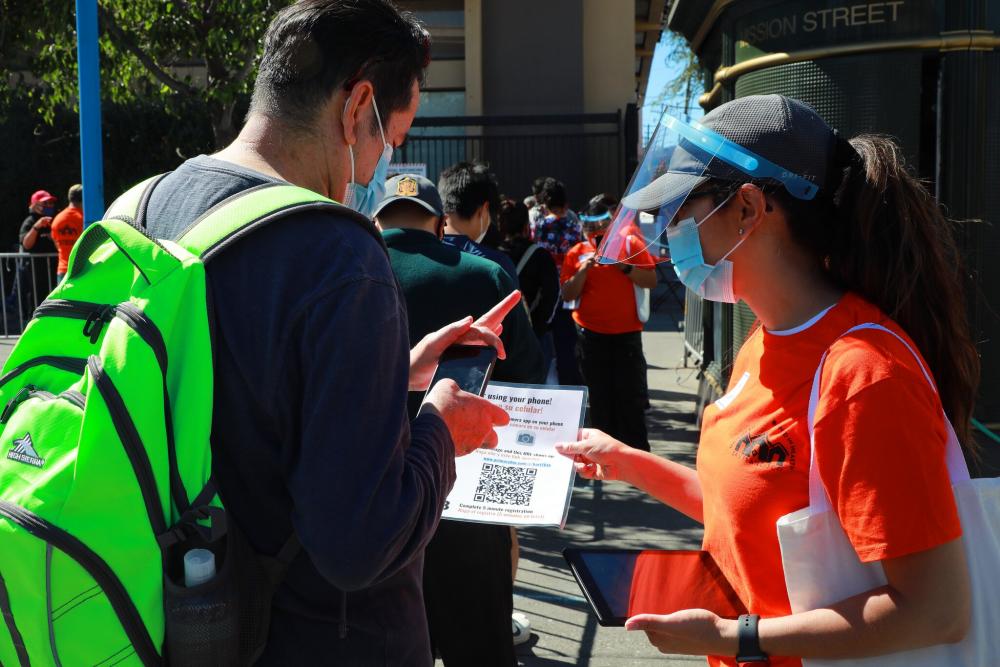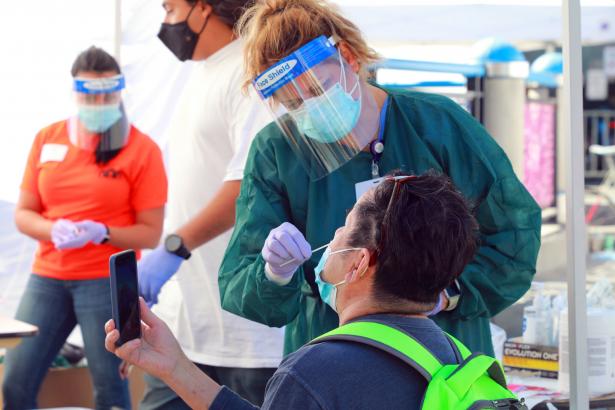A $5 rapid test for the coronavirus may be nearly as effective as the slower, more complex polymerase chain reaction test for identifying people who may spread the coronavirus, a novel experiment has found.
The study, conducted by scientists at the University of California, San Francisco, is among the first head-to-head comparisons of a rapid test and the P.C.R. diagnostic tool under real-world conditions.
But the number of participants was comparatively small, and the data have not been peer-reviewed or published. A rapid test still cannot conclusively determine that an individual is not infected; the tests are intended primarily to detect the presence of high levels of the virus, rather than its absence, and are authorized only to evaluate symptomatic people.
At the moment, anyone who has been exposed to the virus should be tested by P.C.R., said Joseph DeRisi, an infectious disease expert at U.C.S.F. and a co-leader of the project.
Still, the finding offers hope that rapid tests can be used even more widely to help contain a pandemic that is resurging in the United States. Some epidemiologists have argued that the country relies too heavily on cumbersome P.C.R. tests for screening even as the coronavirus flies through communities.

The study was led by Unidos En Salud, a collaboration between researchers at the University of California, San Francisco, and the Latino Task Force on Covid-19. Jim Wilson/The New York Times
The new test, Abbott’s BinaxNOW, offers results in 15 minutes, compared with the days or weeks people may have to wait for a P.C.R. result.
The Trump administration already has purchased 150 million BinaxNOW tests and plans to ship them to states for use in schools, nursing homes and meatpacking plants. The tests could also be used to screen people in communities where time, trust and resources are in short supply.
The study assessed the BinaxNOW in one such community, a largely Latino neighborhood in San Francisco. On three mornings in late September, as commuters emerged from a BART train station in the Mission District, they were offered two nasal swabs: one for a P.C.R. test, the other for the rapid test with a simple readout.
The commuters received only the P.C.R. result, by text, but the researchers compared both tests.
Of the 878 people who took the tests at the train station, only 26 tested positive on the researchers’ P.C.R. BinaxNOW identified only 15 of them.
But many experts have argued that the P.C.R. test is too sensitive, picking up fragments of the coronavirus lingering in the body long after people have recovered and are no longer infectious. A study by the company Becton Dickinson recently showed that rapid tests correlated better with live virus than P.C.R.
But when they only considered P.C.R. results that corresponded to high viral loads, the researchers found that the BinaxNOW test detected 15 of the 16 people who were most likely to transmit the virus.
“This card will do pretty well at detecting the most infectious people, the people who are actually spreading virus,” Dr. DeRisi said, referring to the BinaxNOW. “On the whole, I’m pretty encouraged and very optimistic.”
Dr. Yuka Manabe, an expert in infectious disease diagnostics at the Johns Hopkins Bloomberg School of Public Health, said, “It’s a very nice illustration of how an antigen test could be used in real life and might find those patients who are most likely to transmit disease.”

Abbott’s BinaxNOW test can deliver results in 15 minutes. The Trump administration has purchased 150 million tests to ship to schools, nursing homes and meatpacking plants. Abbott Laboratories, via Agence France-Presse — Getty Images
The new study was led by Unidos En Salud, a collaboration between researchers at the University of California, San Francisco, and the Latino Task Force on COVID-19.
A study in April by the same team showed that 11 percent of Latino participants at another train station tested positive for the virus when P.C.R. was used, compared with 2.6 percent in the city over all.
About 90 percent of people who tested positive in that study were essential workers, and 88 percent made under $55,000 a year, said Jon Jacobo, chair of the health committee for the Latino Task Force. Undocumented community members may also not have access to sick pay or to state and federal benefits, he said.
The task force worked with the researchers to design the study and make it financially possible for those who tested positive to isolate. The organization offered two weeks of groceries to those with positive tests, and a community wellness team delivered other necessities.
Beginning July 1, the city guaranteed two weeks of minimum wage, or $1,285, to anyone who should isolate but could not afford to do so. “The important thing is to always, truly, have a partnership with community,” Mr. Jacobo said.
The project benefited from the researchers’ experience conducting H.I.V. studies in sub-Saharan Africa. “Working in rural areas in Africa is all about talking with the community and asking the question, ‘What works for you?’” said Dr. Diane Havlir, an infectious-disease expert at U.C.S.F. who led the project.
In this case, she said, the community expressed interest in flu vaccination, so the team worked with Walgreens to offer free vaccines at the test site.
Dr. Havlir and other experts acknowledged that BinaxNOW had limitations.
Simple as the test may be, it should be used only by people who are trained to interpret the results, cautioned Jennifer Nuzzo, an epidemiologist the Johns Hopkins Bloomberg School of Public Health.
The task force worked with the researchers to design the study and make it financially possible for those who tested positive to isolate. The organization offered two weeks of groceries to those with positive tests, and a community wellness team delivered other necessities.
Beginning July 1, the city guaranteed two weeks of minimum wage, or $1,285, to anyone who should isolate but could not afford to do so. “The important thing is to always, truly, have a partnership with community,” Mr. Jacobo said.
The project benefited from the researchers’ experience conducting H.I.V. studies in sub-Saharan Africa. “Working in rural areas in Africa is all about talking with the community and asking the question, ‘What works for you?’” said Dr. Diane Havlir, an infectious-disease expert at U.C.S.F. who led the project.
In this case, she said, the community expressed interest in flu vaccination, so the team worked with Walgreens to offer free vaccines at the test site.
Dr. Havlir and other experts acknowledged that BinaxNOW had limitations.
Simple as the test may be, it should be used only by people who are trained to interpret the results, cautioned Jennifer Nuzzo, an epidemiologist the Johns Hopkins Bloomberg School of Public Health.
A representative at Abbott said the ID Now test had been put at a disadvantage in the F.D.A. analysis because of the sample handling method the agency used.
Rapid tests have received a wave of negative attention following reports of inaccuracies in two such tests used in Nevada. The White House once relied on ID Now to screen visitors, a practice many scientific experts regarded as misguided.
Rapid tests are authorized by the F.D.A. for screening people who are symptomatic and early in the course of their illness.
BinaxNOW is the test that produced negative results on “consecutive days” for President Trump, according to a report on Monday from his physician, Dr. Sean Conley.
There is no question that rapid tests are less sensitive than P.C.R., but they are still valuable, said Kelly Wroblewski, director of infectious diseases at the Association for Public Health Laboratories.
“The alternative is that everybody gets a P.C.R., where then you’re going to have delays in getting a result,” she said.
Epidemiologists have wrestled before with the role that rapid testing should play in a fast-spreading epidemic.
In Guinea, during the Ebola outbreak of 2014, most people who were infected experienced fever, diarrhea and body aches — symptoms of any number of pathogens that circulate in Africa.
“We could not scale P.C.R. to screen the thousands of people who have those symptoms every single day in West Africa,” recalled Dr. Ranu Dhillon, an epidemic response expert at Brigham & Women’s Hospital in Boston.
A rapid test in development was stymied by F.D.A. regulations and by concerns about false positives, he said, and was never deployed.
A study in the journal Nature later estimated that rapid screening could have reduced the scale of the Ebola epidemic by one-third.
Apoorva Mandavilli is a reporter for The New York Times, focusing on science and global health. She is the 2019 winner of the Victor Cohn Prize for Excellence in Medical Science Reporting.
She is the founding editor in chief of Spectrum, an award-winning news site on autism science that grew an audience of millions. She led the team there for 13 years. She joined The Times in May 2020, after two years as a regular contributor.
Ms. Mandavilli has won numerous awards for her writing. Her work has been published in The Atlantic, Slate and The New Yorker online, and in the anthology ”Best American Science and Nature Writing.”
She co-founded Culture Dish, an organization dedicated to enhancing diversity in science journalism, and was the founding chair of the Diversity Committee for the National Association of Science Writers. Ms. Mandavilli has a Master of Arts degree in journalism from New York University and a Master of Science degree in biochemistry from the University of Wisconsin-Madison. She is fluent in English, Hindi, Tamil, Telugu and Kannada.


Spread the word